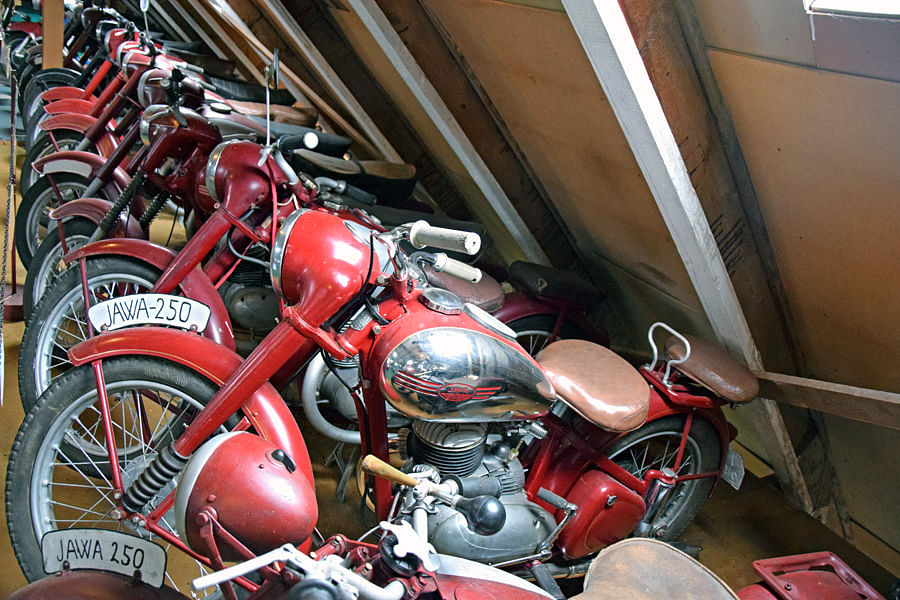
Behind the sepia-tinted photographs, the memories were always there. The news of Jawa returning to India, and rumours of a similar move by Yezdi, have brought them flooding back.
Along with Royal Enfield Bullet and Rajdoot, the two iconic brands represented all that was glamorous and thrilling about motorbiking in India in the 1960s, 70s and 80s.
It was all very different from today, when there is a bewildering array of products to choose from, motorbiking is predictable, and racing gear ensures that safety is a priority.
Back then, trained mechanics were a rarity, tracks were often poor, and racers took off with no safety gear. It all sounds scary now, but that’s how it was, and the memories are sweeter for it.
Jawa recently reintroduced two 300cc twin-cylinder four-stroke models in the Indian market, more than two decades after it left. Exciting news especially for people who raced the earlier avatar.
One such person is Bangalore-based motorsport ace CK Chinnappa. “When they announced that Jawa was going to come back in the Indian market, I was slightly curious,” he said. “We were not sure what engine it would be fitted with because two-strokes are banned now. Obviously, they are four-stroke engines redesigned to look and sound like one from the old Jawa.
“But I felt personally happy and it is very nostalgic for me. A lot of people will grab these bikes to relive the old days,” he added.
Back then, there were no leather overalls or special racing shoes and gloves like now. Jeans, a denim jacket with padding, ankle shoes, leather gloves with a Studds or Grip (now Vega) helmet was just about the safety gear there was.
“We would take stock bikes and modify the engines, replace the stock carburettors with imported Mikuni or other ones. Suspensions were the stock Armstrong or Gabriel,” recalled Chinnappa, who eventually switched to Yezdi and even raced a Rajdoot.
“Mico would give us free spark plugs but we had to sign a bond that if we win, they could be able to say that Mico won it for us. There was a time when Escorts gave me a free engine just for racing,” he said with a laugh. “We sourced the carburettor jets from Phoenix Watch Works (below the now non-existent Plaza theatre) on MG Road in Bangalore. They would drill the jets to our requirement.”
Chinnappa won the Clubmans Stock Class race at the Sholavaram track (on the outskirts of Chennai) in 1978 on a 250cc Yezdi and finished second in a race in Juhu (Mumbai). He also earned victories on a modified Rajdoot in Madras and Calcutta in the late 70s and early 80s in hill climb races (on Nandi Hills), drag races, autocrosses etc.. “For the stock classes, racers back then often stripped the family motorcycle, race with it and fit the removed parts back again,” he reminisced.
The thill was all fine, but what about the danger part of it? “I find it laughable that we raced the way we did. Imagine crashing at high speeds in denim clothes. We just got up and walked away. Thank God, I did not break my bones,” he chuckled. “Nothing can beat the thrill of racing two-stroke machines, but nothing can be done about banning two-stroke engines since it harms the environment.”
“But the point is, we enjoyed what we did. There was no money in it and there was no animosity among fellow racers. We used to ask around for fuel, borrow money for entry fees, beg for tyres. We helped each other,” he stated.
Another individual who has seen the Jawa, Yezdi and Bullets in full glory is former Federation of Motor Sports Clubs of India (FMSCI), the governing body for motorsport in India, President Vicky Chandhok.
“I raced a works Bullet. It was a 200cc bike and I participated in the first ever motocross. The bike worked well for me,” he said. “I owned a Jawa and a Roadking, with Bob Jayaram preparing the bikes for motorsport. So, a Yezdi or Jawa coming back is a hundred percent nostalgic. But at the same time, my nostaliga will be complete if these bikes enter motorsport.”
Chennai-based Chandhok also explained the format at the Sholavaram, an abandoned World War II airstrip. The races were organised by the Madras Motor Sports Club on a T-shaped track with three U bends, two left-handers and two chicanes. All classes, stock and modified, would be run concurrently. As a result, there would be about 90 bikes on the starting grid for the 50-lap races.
Enfield and Escorts fielded a works team. Bob Jayaram, Ravi Thirumalai and Somender Singh were the Jawa experts, while Ashok Nepal was a Rajdoot master. The expert bullet riders were Bhaskar Rao, Subash Chandra Bose, Ravi Krishnan and even AIADMK councillor P Vetrivel.
Towards the end, Chandhok echoed Chinnappa’s thoughts: “We were not really scared. We were pushing it but we had to live with the technology of the time.
“Even though we were deprived of the bikes, the Jawa and Yezdi have remained in people’s minds. However, that noise and screech of the two-stroke engines will never come back,” he concluded.